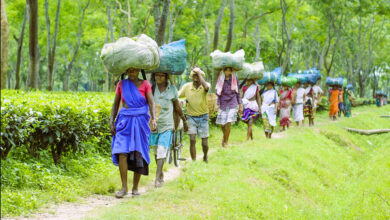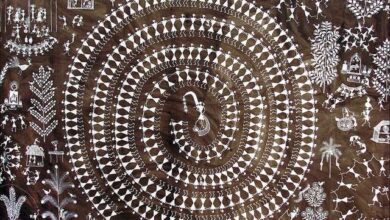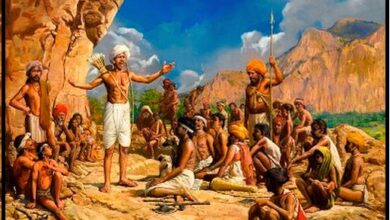Introduction
There are about seven million Adivasis in Assam, scattered either in the 845 odd tea estates or in the villages. Though they form a substantial part of the population of the state, their socio-political and economic conditions are pathetic to say the least. And their plight is deteriorating by the day. One of the major reasons for this backwardness is their abysmally low educational status. This paper tries to find out, at least partially, the educational level of the Adivasis in Assam and some of the reasons behind their low literacy status.
Who are the Adivasis?
Generally people associate the presence of the Adivasis in Assam with the history of tea industry in the state. Anthropologists, historians and sociologists have not tried to link the community to times prior to the inception of the tea industry. But evidences prove that Adivasis were in the Northeast even prior to the coming of the British East India Company. The existence of the Santhal colonies in Western Assam, for instance, show that the Adivasis were not brought to Assam solely for the tea industries.
The presence of Adivasis in Northeast India can be traced back to times immemorial. The first settlers of the undivided Assam seem to be the Khasis and the Syntengs.[1] Linguistically they belong to the Austro-Asiatic or Mon-Khmer group. Through their language they are related to the Munda tribes of central India and many tribes in Myanmar and Indo-China. They resemble them culturally too. For instance, they erect stone monuments to their dead ancestors like the Mundas and Hos of Jharkhand and the tribes of Indonesia.[2] According to historians once Kol-Mundas and the Khasis lived together in Northeast India and the Khasis adopted the language of the Kol-Mundas.[3] Initially the Khasis did not cultivate, and the Mundas called them “Ka-si” which in Mundari means “not ploughing, non-cultivators”.[4] The linguistic and cultural links between the Khasis of Northeast India is another proof of the presence of the Mundas in Northeast India. But it is a fact that large number of Adivasis were brought to the tea gardens of Assam from 1841 as indentured labourers. Their descendants are today found in the tea gardens or villages of Assam. According to the Bihar Scheduled Tribes list, Adivasi tribes include Asurs, Baigas, Banjaras, Bathudis, Bedias, Bhumijs, Binjhias, Birhors, Birjias, Cheros, Chik-Baraiks, Gonds, Goraits, Hos, Karmalis, Kharias, Karwars, Kisans, Koras, Korwas, Lohars, Mahlis, Mal-Paharias, Mundas, Oraons, Paharias, Santals, Sauria-Paharias, and Savars.[5] Apart from the present day Jharkhand, they are also migrated to Assam from Chhattishgarh, Madhya Pradesh, Orissa and West Bengal.
Educational scenario among the Adivasis in Assam
Undoubtedly vast majortity of the Adivasis in Assam are illiterate. A survey by Fr. Hippolitus Toppo, a scholar from the tea garden community, shows that in 1994, in the 845 tea estates of Assam, there were 34,400 children studying in 666 tea garden schools, while there were 89,598 child labourers.[6] In fact,, till the end of the last century only about 10% of them were literate, which is an abysmally low percentage. Lack of education is the main cause of exploitation of these people by the non-Adivasi society. Dr. Virginius Xaxa, a scholar of sociology in New Delhi School of Economics, wrote in the Times of India in 1997:
The living standard of tea plantation workers is extremely low. This has bearing on the level of literacy and the quality of health of the tea garden population. The literacy level stands at about ten percent and the population prone to all kinds of diseases has a low life expectancy. The area is even today characterized by very low level of urbanization, education, level of income, social service, etc. Much of this has been due to the indifference of the industry to the needs of the region.[7]
In 1999 a brief survey of tea garden labourers was done by Fr. Thomas D’Silva among 560 families from seven tea gardens, namely, Badlapara, Bhutiachang, Borangajuli, Dimakuchi, Nonaipara, Orangajuli and Paneri in the District of Darrang, Assam. According to this study, the following was the number of students in the lower primary, primary, high schools and colleges in the seven gardens:
| T. E. | Lower Primary
(Cl. I-III) |
Primary
(IV-VI |
High School | College |
| Badlapara | 103 students | 86 students | 50 students | 2 students |
| Bhutiachang | 77 students | 47 students | 38 students | 6 students |
| Borangajuli | 13 students | 15 students | – | – |
| Dimakuchi | 28 students | 6 students | 8 students | 1 student |
| Nonaipara | 81 students | 57 students | 30 students | 3 students |
| Orangajuli | 85 students | 15 students | 83 students | 32 students |
| Paneri | 27 students | 16 students | 8 students | 1 student |
| Total | 414 students | 242 students | 217 students | 45 students |
The literacy rate in these seven tea gardens was very low. If we take an average of 5,000 people in a garden, out of 35,000 people (5,000 x 7) only 656 students were in the lower primary and primary schools, 217 in the high schools and 45 in the colleges.[8]
According to the 2001 census, Jorhat District of Assam had the highest literacy rate in the state. But a recently concluded study by the Northeastern Social Research Centre, Guwahati, shows that among the plantation labourers educational level is the lowest in the same District of Jorhat.
A survey by Assam Sarba Sikshya Abhijan Mission (ASSAM) shows that while in Assam 25% of the children in the 6-14 age group are out of school, among the tea garden workers their proportion is 43%. Out of 246,843 children in the garden areas in the 6-14 age group, 105,821 (42.87%) are out of school.[9]
Already 59 years have passed since the PLA was enacted. Yet 55.54% of plantation workers’ children have not entered a school. Moreover, 438 males (18.61%) and 307 females (13.62%) or a total of 16.07% have dropped out after primary school, 328 males (13.94%) and 173 females (7.68%) or a total of 501 (10.87%) have dropped out after ME school. Thus those who never entered a school (55.54%) and those who dropped out of primary and ME school (26.94%), together form 82.48% illiterate and semi-illiterate children in the 6-14 years group. They are forced to remain without any hope of a better future.[10]
Constraints to Education and Possible Solutions
- Poverty
The tea garden workers are poorly paid. Their meager earnings cannot even adequately meet their daily needs. Even those living in villages are poor as their land holdings are becoming smaller by the day and there are others who are becoming landless. All these and other factors make education of their children a distant dream. Some possible solutions to improve economic status and facilitate education would be:
(a) Cultivating saving habits:
If the Adivasis are taught to save a little but regularly even from their meager earnings, their economic condition is bound to improve.
(b) Self-Help Groups:
Formation and participation in self-help groups are another means of improving people’s economic situation.
(c) Regulating Expenditure:
Budgeting a family’s expenditure and avoidance of unnecessary expenditure (like alcoholism, gambling, over-spending on celebrations etc.) can alleviate poverty to a great extent.
(d) Better Wages:
Assam tea gardens pay the lowest wages to the plantation workers. There must be lobbies to fight for better wages.
(e) Search for Govt. aids
Govt. funds should be discovered and made known to the people so that people can benefit from them.
(f) Intensive schools
Helping non-school-going children to pass many classes in shorter time through intensive schooling and admitting successful students in regular schools.
- Lack of Motivation
It happens that some parents refuse to send children to school even when some opportunities are offered to them. One of the reasons is that they do not see the usefulness of studies. They prefer the children (especially boys) to work and augment the meager income of the family or to make the girls to look after their siblings. To solve this problem to some extent the following could be helpful:
(a) Seminars
Seminars could be organized both for the educated and especially at the grass-roots level to help create awareness about the importance of studies.
(b) Making use of any public forum
Whenever an opportunity is available, make use to speak to the people about the necessity of education for a successful and meaningful living.
(c) Printed media
Printed media like magazines (e.g. Gharaiya Goith), leaflets, etc., could be used to highlight the sine-qua-non requirement in today’s society. Such means can be used also to publicize success stories from our society. This will encourage people to appreciate education.
(d) Modern media
Radio talks, audio cassettes, films etc. are powerful means to influence people. Educational radio talks, catchy songs, attractive documentary/story films could be produced (at low budgets) to help people to appreciate education.
(e) Street theatre
Street theatres are cheap but powerful means of making people understand the utility of education especially in today’s society.
(f) Preparatory schools
Preparatory schools like the Bosco Xixu Vikas Kendra at Harmutty, Bosco Mangal School in Imphal, can motivate and prepare children to join regular schools (e.g. Govt. Schools).
(g) Incentive – through awards to meritorious students…
- Gender Bias
Many of the Indians, including the Adivasis, do not like to educate girls. The Adivasis say “Beti to dosra ker chulha phukek jai…). But we must remember that even if an educated girl is a “loss” to the family, she certainly is a gain to the society. Moreover, a girl has as much right to study as a boy.
- Diversity
A child understands educational concepts better in his/her own mother tongue. Cultural and especially linguistic diversity found in Assam is a quoted as a great hindrance to finding a suitable medium of education. Fr. Zepherinus Baxla sdb has tried to experiment successfully with the use of Kurukh medium of instruction in his “Lur Dipa” school in Jharkhand. Mr. Wilfred Topno, Director of Adivasi Sahitya Sabha, Assam, is trying to experiment with Sadri medium school.
PAJHRA has tried to study the possibility of bringing MLE – Multi – Lingual Education which refers to “first-language-first” education, that is, schooling which begins in the mother tongue and moves to additional languages…[11]
Some are of the opinion that those who cannot afford financially should make use of the existing Assamese medium schools (possibly with help at home with coaching) and English medium schools for those who can afford.
- Management’s clever machinations
It is often heard or even understood that tea garden management is not really interested to educate children of plantation labourers because they fear loss of cheap labour force…
As a solution it must be emphasiszed that the management should be strongly reminded that they are obliged to implement the steps suggested in the Plantation Labour Act 1951. Besides many other steps the PLA 1951 demands provisions for housing and for children’s’ education. The Act stipulates that when the workers’ children aged 6-12, exceed 25 in a garden or division the employer should provide and maintain at least a primary school for imparting them primary education. If the management does not maintain it because a public school is situated within a mile from the line, then the employer is required to pay a tax for their primary education.[12]
It must be demanded that the Lower Primary, Primary, Anganvadi schools and the crèche must be in the same premises so as to facilitate the school attendance of the girl child. Teachers in the garden schools must be sufficient in number and well trained as well as paid adequately. Teachers should not be part-timers.
Wherever garden schools are few in number venture schools could be opened by trained youth, with the community’s help to supplement the paucity of schools.
- Government’s Apathy
The unjust de-scheduling of the Adivasis in Assam is a pure sign of the state government’s apathy towards to the welfare of the Adivasis. Concerted and persistent demands must be made till the Adivasis in Assam are re-scheduled.
The state government also must be constantly reminded to pressurize the tea management to implement the provisions of the PLA 1951.
- Opposition from other groups
There could be other groups with vested interests who do not want to see the educational progress of the Adivasis and may even vehemently and subtly oppose it. In such cases there must be united stand among the Adivasis to speak out and to act for their God-given rights.
- Literates helping non literates
Padho aur parhao – study and educate…..
- Consortium
a body which will coordinate and monitor the educational activities by the government, management and other organizations. Could PAJHRA be this body forming the consortium?
Conclusion
According to recent data available the literacy rate among the Tea Garden community is 20%.
Some data are also available on those who have climbed the upper reaches of higher education. As the recent data show currently there are:
-
- 8 PhD holders among the Adivasis in Assam
- 230 Master’s degree holders
- 2623 Graduates
- 97 MBBS (doctors)
- 16 Engineers
- 28 LLB (law graduates)
- 15 Agriculturists (Agriculture B.Sc. degree holders)
- Magistrates (2 APSC, 1 ICS)
- 3 MBA certificate holders
- 2 Veterinary doctors, etc.
There are also some professional and free-lance journalists and electronic media personnel. These are some success stories among many others which also must be discovered and made known.
This paper does not claim to be scientific or exhaustive. But if it can elicit some thought and useful discussion to find out some solutions to one of the greatest problems, namely, educational backwardness among the Adivasis in Assam, it will have served its humble purpose.
[1] Cf. Wilfred Topno, “Adivasis of Assam And Christoson Munda” in Turtan Singi, Birsa Munda’s 134th birth anniversary souvenir, 2010, p. 49; see also Asomiya Jatir Itibrito – Assam Sahitya Sabha 1995.
[2] Stephen Fuchs, “The Races of Northeast India”, in The Catholic Church In Northeast India 1890-1990, ed. S. Karotemprel, 1993, p. 363.
[3] Wilfred Topno, op. cit., p. 48; see also Asomiya Jatir Itibrito – Assam Sahitya Sabha 1995.
[4] Ibid., p. 48; cf. also Adivasi Awaz, Vol. 3, p. 7 ff.
[5] Prasad, N., Land and People of Tribal Bihar, Ranchi: Bihar Tribal Research Institute, Government of Bihar, 1961, pp. 15-16.
[6] Walter Fernandes & Co., Children Of The Plantation Labourers And Their Right To Education, Guwahati: Northeastern Social Research Centre, 2003, p.1.
[7] Cf. V. Xaxa, “Why Assam Tea is Troubled Brew?”, in Times of India, 13 April 1997, p. 7.
[8] Cf. Thomas Pulloppillil, ed., Identity Of Adivasis In Assam, Delhi: Indian Publishers Distributors, 1999, p. 177.
[9] Walter Fernandes, op. cit., p. 1.
[10] Ibid., p. 11.
[11] Cf. PAJHRA Annual Report 2009-2010, Tezpur,, Assam, pp.17-19.
[12] Walter Fernandes, op. cit., p.7.




